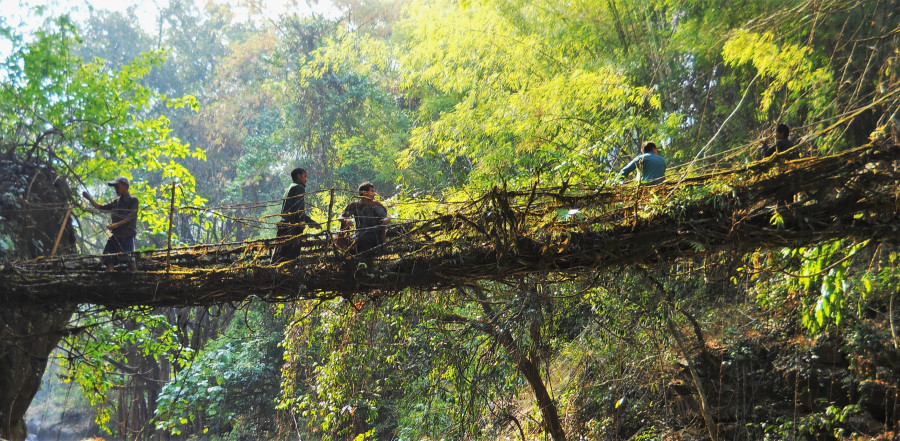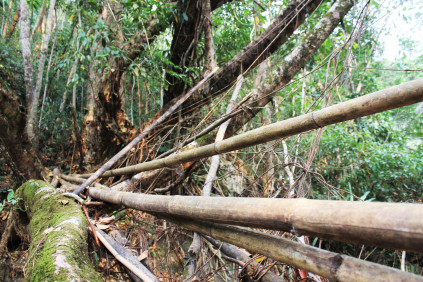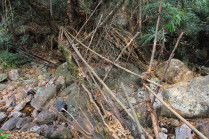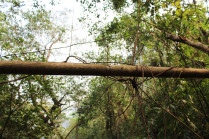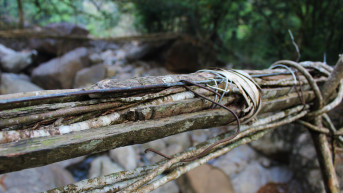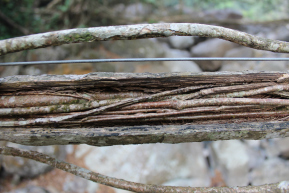A living root bridge is created using the pliable aerial roots of the ficus elastica species of fig tree. The natural growth of the roots is harnessed in such a way that they are gradually trained into the desired architectural structure, using both their tendency to anchor themselves to other objects and their propensity to combine with each other via the process of Inosculation. This can take many years, though the exact amount of time necessary for a root bridge to become functional is highly variable, and dependent on local factors such as how healthy the tree is, how flood-prone the stream the bridge crosses is, how much those crossing the bridge mind wobbly roots, and what level of community involvement there is in developing the structure.
Based on my investigations, it’s clear that there are several methods of generating a usable living root bridge, and these methods vary from example to example and from area to area. However, it is important to note that in all instances the creation of a living root bridge is very much a long-term, social, process, with additions and improvements being made well after the initial planters have died. After a root bridge’s initial period of development, it is reinforced when people using it simply rearrange the naturally growing roots found on the span in an opportunistically beneficial way. Because of this, root bridges can be seen as continual works in progress, with many successive generations contributing to them. An example that’s hundreds of years old is still part of a living, changing, developing, organism.
Unfortunately, given that the practice is fading in so many areas where it was once widespread, and that newly created living root bridges are so rare (especially outside of tourist areas), it’s difficult to observe new bridges under construction using traditional methods. It may well be that a greater body of expertise on the subject once existed, but has since faded. Often, there is very little information about how a given bridge was initially formed.
I’ve arranged the methods of creating living root bridges into four broad groups. Bear in mind that, given the organic nature of the structures in question, the construction of a single bridge might involve several, or even all, of these.
The methods are:
a): Root bridge training without scaffolding.
b): Root bridge training using bamboo or wood scaffolding.
c): Root bridge training using hollowed out Areca Palm trunks.
d): Root bridge training using steel wire.
ROOT BRIDGE TRAINING WITHOUT SCAFFOLDING
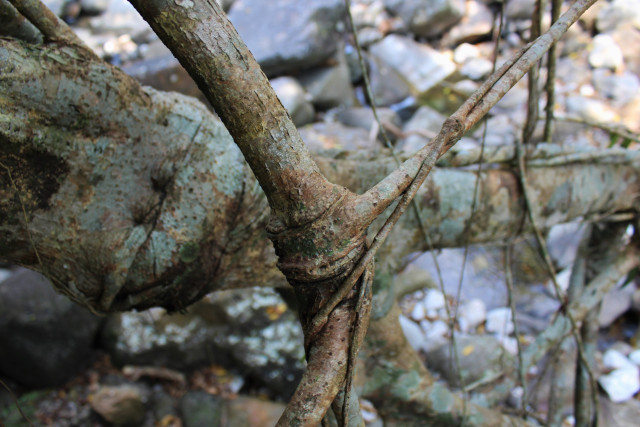
Almost all living root bridges that I’ve observed which were still being actively maintained showed signs of roots that had been manipulated by hand to improve the functionality of the structure. These improvements often took the simple form of a few individual roots that had been wrapped around each other, tied to trees, or attached to the opposite bank of a stream. I’m told that these ad-hoc, spur of the moment improvements are usually done by people working in the jungle, who have occasion to use the living root bridge, and so take it upon themselves to improve the structures over time.
The people making these improvements understand that, gradually, individual roots tied or twisted together will merge, forming a stronger overall structure.
The slideshow below shows a living root bridge where virtually all of the recent maintenance has been in the form of roots being manipulated by hand, without the use of a scaffold.
For more information on this bridge, go to: Laitiam 1
While the methods used in the initial generation of many older bridges is often not clear, I have seen examples where no scaffolding was ever used, and where the structure was formed entirely by manipulating roots by hand.
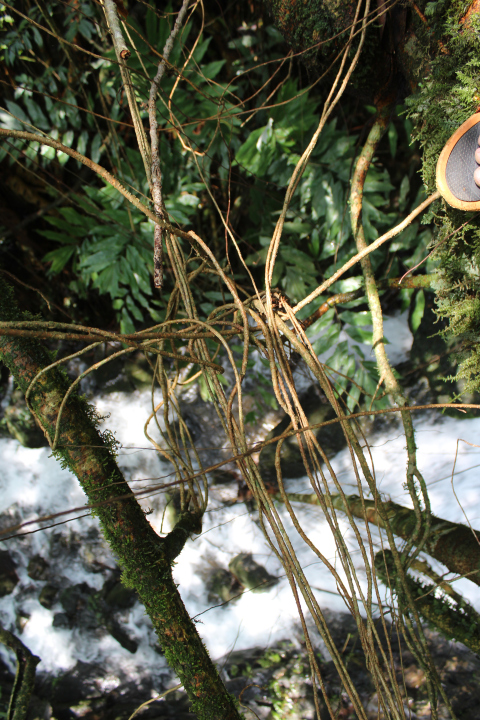
The northern span of the double root bridge pictured below was generated entirely without the use of a scaffold, and all maintenance and further development of the span has been done by hand. The span was first brought into existence by the man in the red shirt you can see working in the pictures.
For more information on this bridge, go to: Burma 1
The slideshow below shows a damaged living root bridge undergoing significant repairs, most of which are in the form of aerial roots simply being tied together and readjusted (though some bamboo is also used). I visited the same bridge a year later and found many of the manipulated roots still in place.
ROOT BRIDGE TRAINING USING WOOD OR BAMBOO SCAFFOLDING
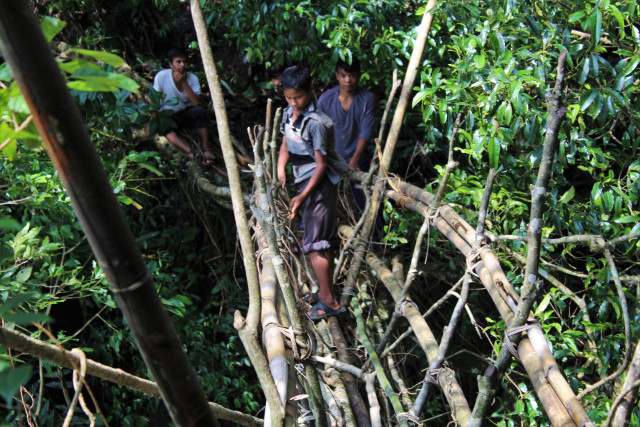
Many root bridges are created using scaffolds made of wood or bamboo, materials which can be found virtually anywhere in Southern Meghalaya.
In these instances, young ficus elastica roots can often be seen twisted around bamboo poles, while sticks and tree trunks are used to add additional stability to a temporary structure which crosses a stream and is used to aid in the formation of a botanical structure. While these materials rot quickly in the hot, humid, climate of Southern Meghalaya, given their ubiquity, they can easily be replaced from year to year.
The roots, providing the tree they are a part of remains healthy, gradually become stronger and thicker, and with many adjustments to the scaffold over time, will slowly develop into a functional living root bridge. Once the roots can be safely walked upon, the scaffolding is no longer necessary. However, additions and repairs to already functioning root bridges are still often made by guiding aerial roots along the outsides of sticks, tree trunks, or bamboo poles.
This method of root bridge creation appears to be practiced throughout the area where they are found. In some areas, root bridges are also created using a method employing hollowed out Areca Palm trunks (see the next section). However, in areas where Areca Palms do not grow in abundance, the use of wood or bamboo scaffolding is simply more practical.
I’ve also had the opinion expressed to me that the Areca Palm method is more time consuming, meaning that even in some areas where Areca Palms are common, the locals still opted to use a bamboo or wood scaffold because they thought that would be easier.
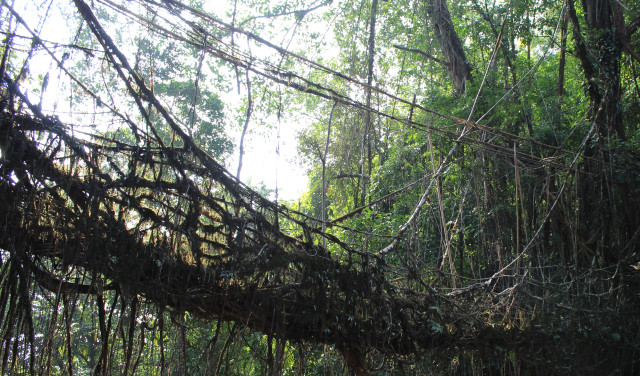
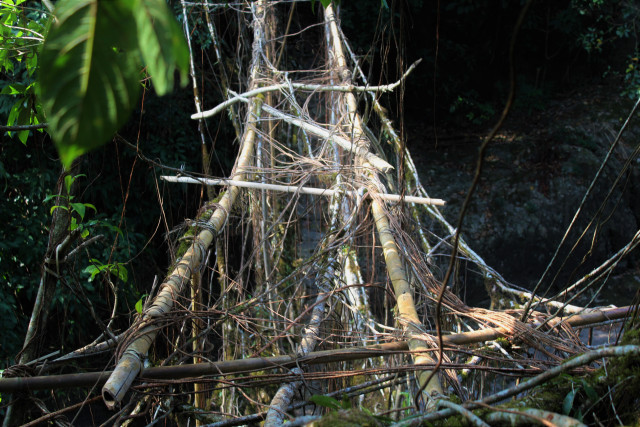
The photos below are of a root bridge where a scaffold has been created very recently, even though the primary root of the structure is fairly well established.
The slideshow below depicts a root bridge which existed as a few strands strung across a stream in 2015, though it was later significantly developed using a bamboo and wood scaffold.
ROOT BRIDGE TRAINING USING HOLLOWED OUT ARECA PALM TRUNKS
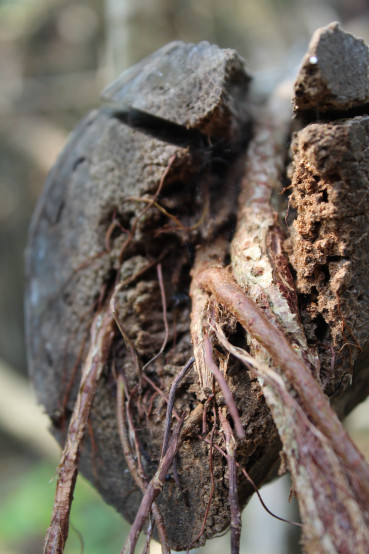
The most well known method for creating living root bridges is to use the hollowed out trunks of Areca Palms. These are placed across streams and rivers, and then young ficus elastica roots are guided through them. The trunks serve to direct the roots, to protect them, and also to provide them with nutrients as they decompose. In this way, a strand guided across a stream using an areca trunk has a solid chance of growing thick enough to become a useful part of an architectural structure. Usually, the hollow trunks are incorporated into some variety of wood or bamboo scaffolding.
There are only a few instance where this method of root bridge generation can be observed, and these are mostly in tourist areas. Here, the scaffolds that incorporate hollowed out Areca Palm trunks often also employ steel wire and other materials.
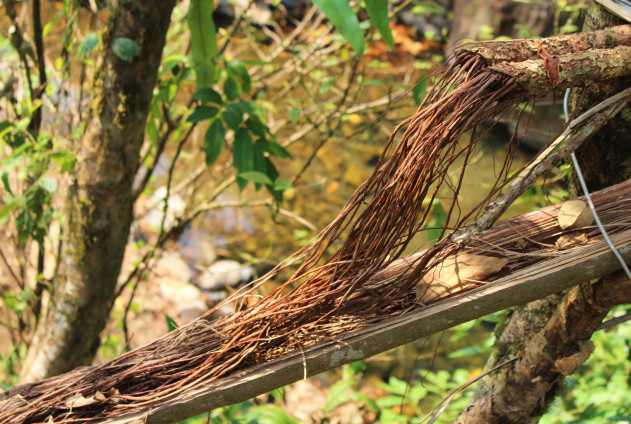

This means of creating living root bridges is practiced around the village perhaps best known for its living root bridges: Nongriat. This is a tourist friendly area, and so the use of Areca Palm trunks can be easily observed not only in Nongriat village, but also in the nearby settlements of Nongthymmai and Mynteng.
The photos above show a new railing being grown on a tourist-frequented root bridge near the village of Nongthymmai using ficus elastica roots directed through an Areca Palm trunk. Wires and bamboo strips are also being used.
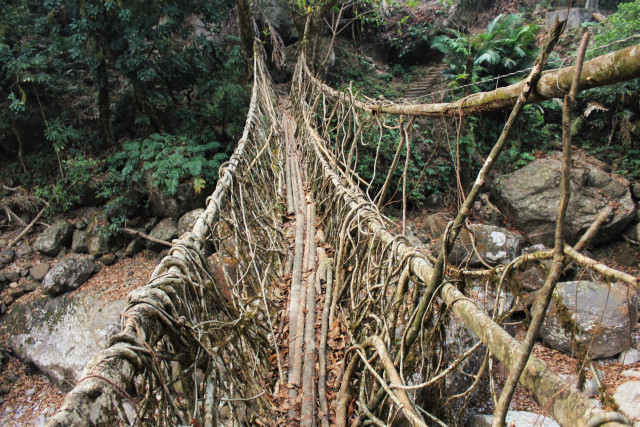
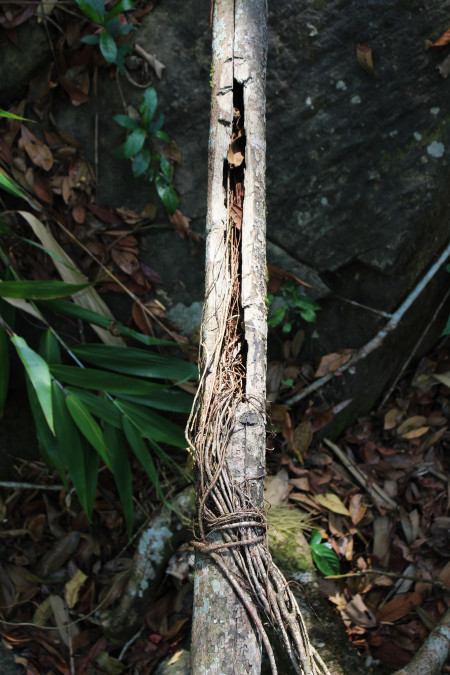
ROOT BRIDGE TRAINING USING STEEL WIRE

While it is not common, it is possible to develop living architecture using steel wire. Though conventional elements have often come to replace root bridges entirely, in a few places they have been incorporated into living structures.
Near the village of Nongriat, there is a particularly interesting example of a “hybrid” structure, where ficus elastica roots have been trained across a pre-existing steel wire bridge. Here, the immediately usable, conventional, structure doubled as a scaffold on which to develop a root bridge. As the roots have grown and gained in strength, the steel wires have become effectively redundant, and will probably be allowed to rust away sometime in the future. In this way, the long phase of root bridge development during which the structure is not usable because it is still too young and its roots are too thin has effectively been bypassed.
In some examples of recently damaged or recently developed living root bridges, steel elements have been used to repair and help regenerate the structures.
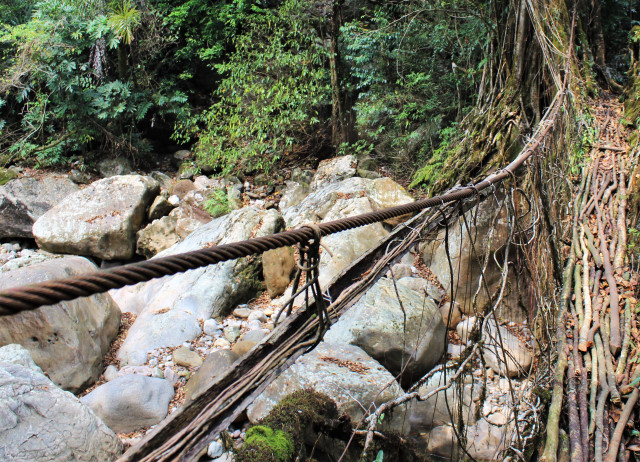
In the village of Nongpriang, there is a living root bridge which has fallen, and was directly replaced by a steel wire bridge. Here, roots from the trees that made up the original living structure are being trained across the wires of the new bridge. The roots from the two trees have been tied together, and so it is not impossible that, one day, the conventional steel bridge could be used to develop a new root bridge at that location.
RANGTHYLLIANG/MAWKYRNOT 1: A CASE STUDY
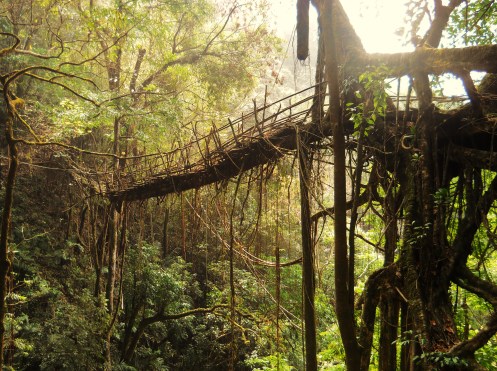
Rangthylliang/Mawkyrnot 1 is a large root bridge, which, though part of it appears to be old and well established, has nonetheless been developed extensively in the last few years by a local tourism society. Examples of all four of the training methods listed above are present at this bridge, which allows it to serve as a sort of “showcase” for all of the different ways in which living architecture can be generated.
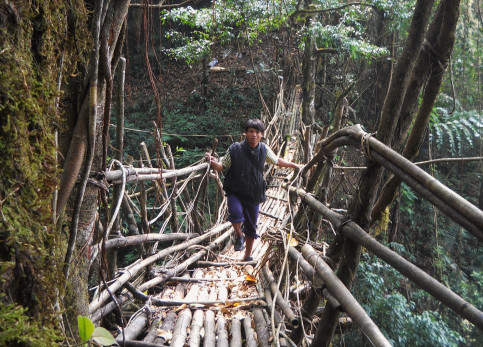
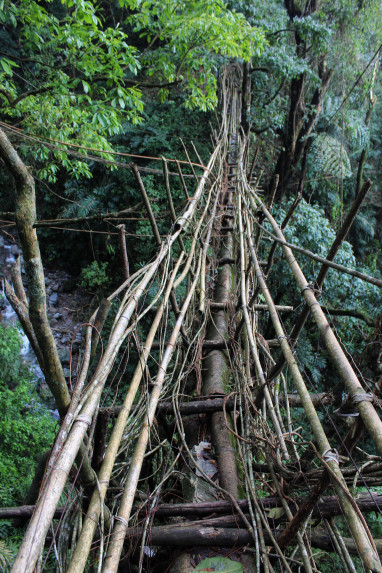

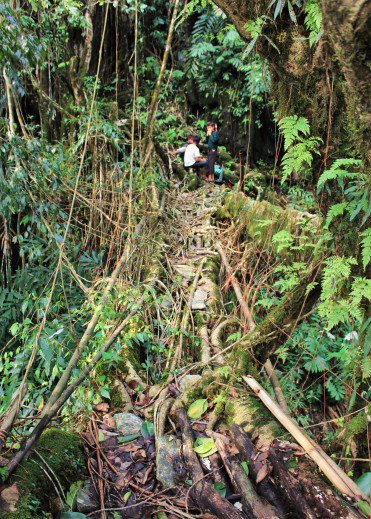
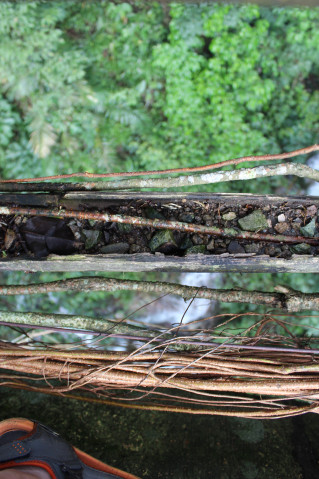

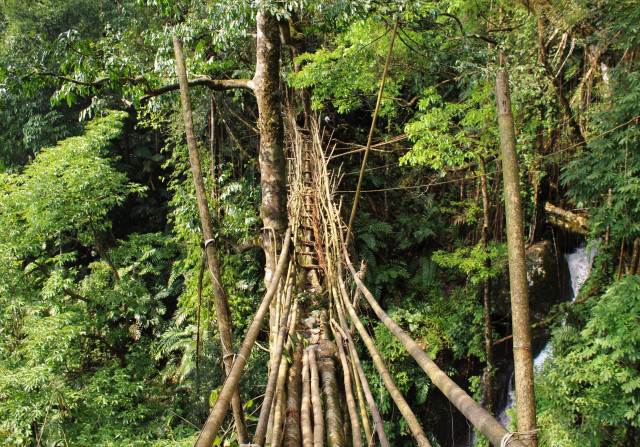
CONCLUSION
While it goes without saying that the ways in which living root bridges are created deserve attention from academics in a variety of fields, it is also important to remember that the people who made them did so without what we would call scientific or engineering expertise. There were no blue prints, and the structures were not planned by professional architects, but by agriculturalists who had to solve a very basic problem.
In a way, I feel this makes the bridges all the more exceptional, in that they are instances of functional architecture that have often seen hundreds of years of service, are in some cases stronger now than ever before, are objects of incredible aesthetic value, and yet they are products of, for lack of a better term, “amateur” architects. What this means is that the basic idea of a living root bridge, despite seeming so unusual and ingenious, is nonetheless something that could be easily transplanted to other contexts. Various kinds of banyan trees can grow in many different environments, from urban areas in Bangladesh, to parts of southern Florida, to indoor gardens anywhere in the world.
